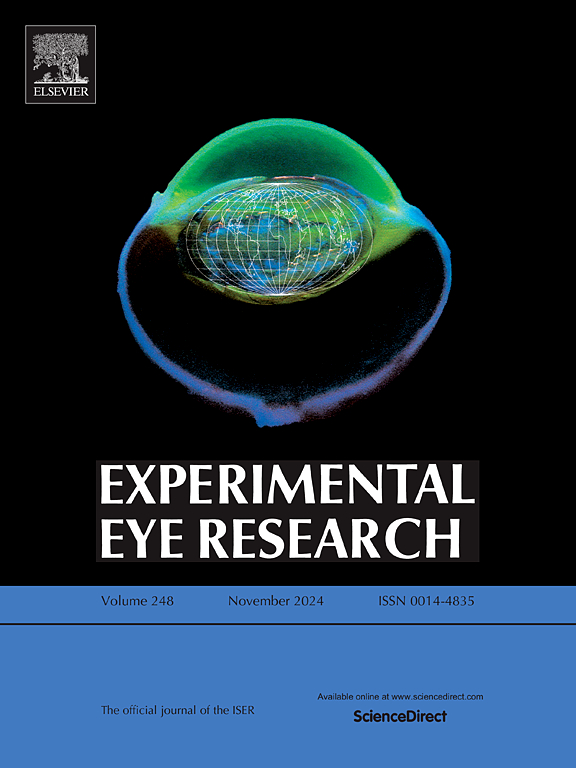Inhibiting effect of LIPUS on epithelial-mesenchymal transition in lens epithelial cells
IF 3
2区 医学
Q1 OPHTHALMOLOGY
引用次数: 0
Abstract
To investigate the effect of low-intensity pulsed ultrasound (LIPUS) on epithelial-mesenchymal transition (EMT) in lens epithelial cells. EMT was induced using high glucose (HG) in SRA01/04 cells. Optimal parameters for LIPUS irradiation were determined by cell counting kit-8 assays and flow cytometry. Cell morphology was assessed by light microscopy, while cell migration ability was analyzed by a wound healing assay. Levels of specific proteins and the relationship between autophagy and the cytoskeleton were examined by immunofluorescence (IF) staining and Western blot (WB). Cytoskeletal structures were visualized by phalloidin staining and autophagosomes were quantified by transmission electron microscopy. EMT was successfully induced by HG treatment. Compared to the model group, LIPUS irradiation resulted in a change in cell morphology from spindle to oval, a significant decrease in cell migration area, and an increase in E-cadherin and LC3B/LC3A levels. In contrast, α-SMA and SQSTM1/P62 levels decreased, the number of autophagosomes increased and F-actin levels decreased in the LIPUS group. SRA01/04 cells treated with LIPUS irradiation after autophagy inhibitors 3-MA and CQ showed increased cell migration area compared to the 3-MA/CQ group; LC3B/LC3A levels decreased; SQSTM1/P62 and F-actin levels increased in the LIPUS + 3-MA/CQ group compared to 3-MA/CQ treatment alone. Colocalization of the cytoskeletal marker Arpc2 with the autophagy marker SQSTM1/P62 was also observed. After treatment with the cytoskeletal inhibitor CK666+LIPUS combination therapy, SQSTM1/P62 levels increased while LC3B/LC3A levels decreased. LIPUS inhibited HG-induced EMT by restoring autophagy, which appears to be associated with cytoskeletal remodeling.
LIPUS对晶状体上皮细胞上皮间质转化的抑制作用。
探讨低强度脉冲超声(LIPUS)对晶状体上皮细胞上皮-间质转化(EMT)的影响。采用高糖(HG)诱导SRA01/04细胞EMT。通过细胞计数试剂盒-8和流式细胞术确定LIPUS辐照的最佳参数。通过光镜观察细胞形态,通过伤口愈合实验分析细胞迁移能力。免疫荧光(IF)染色和免疫印迹(WB)检测细胞自噬与细胞骨架的关系。用phalloidin染色观察细胞骨架结构,透射电镜观察细胞自噬体。HG处理成功诱导EMT。与模型组比较,LIPUS照射导致细胞形态由纺锤形变为卵形,细胞迁移面积明显减少,E-cadherin和LC3B/LC3A水平升高。相反,LIPUS组α-SMA和SQSTM1/P62水平降低,自噬体数量增加,F-actin水平降低。与3-MA/CQ组相比,自噬抑制剂3-MA和CQ组经LIPUS照射后的SRA01/04细胞的细胞迁移面积增加;LC3B/LC3A水平降低;与单独使用3-MA/CQ治疗相比,LIPUS + 3-MA/CQ组SQSTM1/P62和F-actin水平升高。我们还观察到细胞骨架标记Arpc2与自噬标记SQSTM1/P62的共定位。在细胞骨架抑制剂CK666+LIPUS联合治疗后,SQSTM1/P62水平升高,LC3B/LC3A水平降低。LIPUS通过恢复自噬来抑制hg诱导的EMT,这似乎与细胞骨架重塑有关。
本文章由计算机程序翻译,如有差异,请以英文原文为准。
求助全文
约1分钟内获得全文
求助全文
来源期刊

Experimental eye research
医学-眼科学
CiteScore
6.80
自引率
5.90%
发文量
323
审稿时长
66 days
期刊介绍:
The primary goal of Experimental Eye Research is to publish original research papers on all aspects of experimental biology of the eye and ocular tissues that seek to define the mechanisms of normal function and/or disease. Studies of ocular tissues that encompass the disciplines of cell biology, developmental biology, genetics, molecular biology, physiology, biochemistry, biophysics, immunology or microbiology are most welcomed. Manuscripts that are purely clinical or in a surgical area of ophthalmology are not appropriate for submission to Experimental Eye Research and if received will be returned without review.
 求助内容:
求助内容: 应助结果提醒方式:
应助结果提醒方式:


